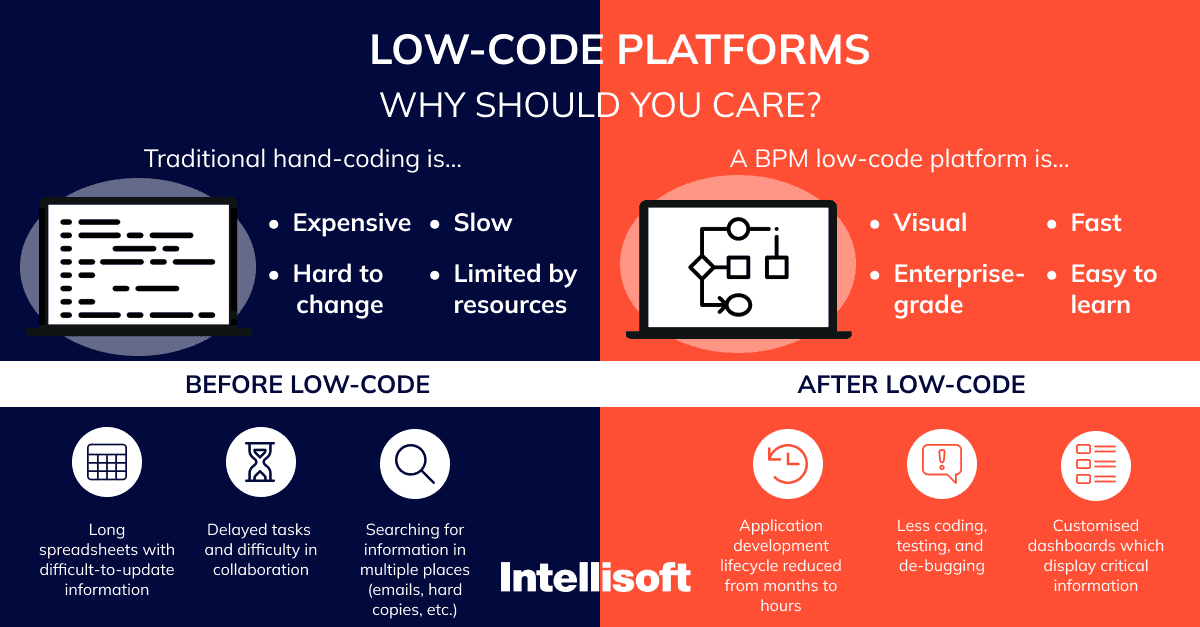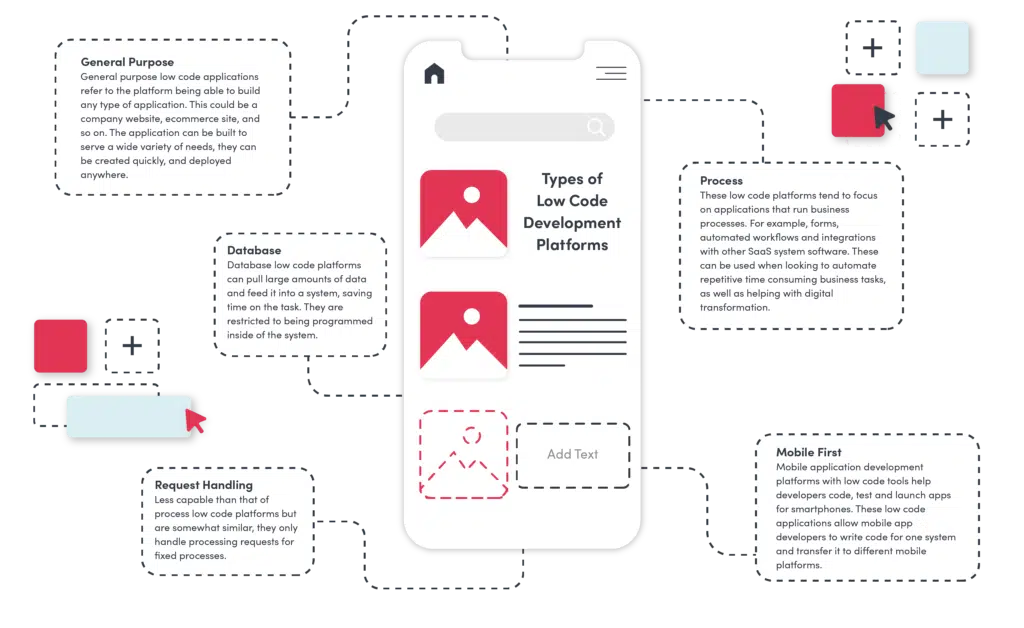Best Suggestions To Picking Low-Code Platform Recommendations
Best Suggestions To Picking Low-Code Platform Recommendations
Blog Article
Advantages Of Low Code Application Development In Relation To Integration Capabilities
Low-code development is an excellent method to create applications that are able to seamlessly integrate diverse platforms and services. These are the advantages of APIs and connectors that are pre-built:
Connectors that are wide-ranging: Low code platforms have a vast collection of pre-built connectors to the most popular enterprise systems (e.g. ERP, CRM databases and cloud services). This allows for easier integration with systems.
API Integration - Many low-code platforms include API integration that gives developers to easily access other data sources or external services.
Easy To Use
Drag-and-Drop Integration integration tasks can usually be accomplished using drag-and-drop interfaces, making it accessible to both developers and non-developers to create complex integrations without writing extensive code.
Visual Workflow Creators: These visual tools that are used to design workflows and data flows makes it easier for users to comprehend the integration process.
Standardized Integration Methods:
SOAP/RESTful Service Support: Standard web services protocols, like SOAP/REST, facilitate the integration of a variety of external applications and systems.
OData, Other Standards Support for standards such as OData allows access and manipulation data across applications and platforms.
Real-Time Data Synchronization:
Real-Time Integrations: Low-code devices are able to handle real-time data synchronization between applications and systems, assuring that data is always up-to-date and uniform across the entire organization.
Event-Driven Architectural: Some platforms feature architectural designs driven by events that allow applications to respond in real-time, to events essential to create interactive and dynamic applications.
Legacy System Integration:
Low-code platforms: These can be used to connect older systems to modern systems. They're a great method to upgrade your IT infrastructure, without having to overhaul everything.
Data Migration Tools: Built-in software helps transfer data from older applications to new ones that are built on platforms that have low-code.
Third-Party Service Integration:
Integration with Cloud Services: Seamless integration with cloud-based services like AWS, Azure, and Google Cloud allows for the easy deployment and scaling of applications.
Business Integration of Applications: Low code platforms can be integrated with various business software like Salesforce, SAP and Microsoft Dynamics. This facilitates seamless flow between the business processes.
Simplified data management:
Unified Data Models: Some low-code platforms provide unified data modeling which makes data integration easier and management across various systems.
Data connectors: These preconfigured data connectors allow easy access and modification to data from multiple sources.
Security and Compliance
Secure Integrations - Low-code platforms have been designed to ensure that all integrations adhere to security standards and protocols. This helps protect information both during its travel and when it is being stored.
Compliance Features: These platform typically have features that assure that integrations are in compliance with the requirements of regulatory agencies, like GDPR and HIPAA. This provides peace ofmind for businesses handling sensitive information.
Extensibility:
Low-code platforms are able to accommodate complex integration requirements by adding custom code or scripts. They allow for flexibility without compromising the ease of use.
Plug-in Ecosystems: A plugin ecosystem can be used to extend the integration capabilities, and allow users to add additional functionalities when needed.
Overall, the capabilities for integration of low-code application development platforms make them an excellent device for building connected, efficient and scalable apps. They simplify the process of connecting different systems, improve the flow of data and enable companies to take advantage of new technologies while using existing ones. Take a look at the most popular helpful resource for Low-code Platform for application development for more tips including rapid application design, no code platforms, develop cross platform mobile app, cross platform mobile dev, app platforms, app platforms, cloud software applications, azure sql server, cross platform app development, app modernization and more.
Benefits Of Low-Code Application Development In Security And Governance
Low-code application development offers several benefits in terms of security and governance. These are essential for ensuring that applications are compliant, secure, and well-managed throughout their lifecycle. Here are a few of the main benefits:
Unified Manage Console: Lowcode-based platforms usually offer a management console that allows administrators to oversee and manage applications.
Role-Based Access Control RBAC: These platforms are equipped with robust role-based controls that allow administrators to establish access policies. This allows only authorized users to alter or access specific parts of a program.
Compliance and Regulatory Adherence
Built-in Compliance Features: A lot of low-code applications are designed to comply with industry norms and regulations (e.g. GDPR, HIPAA). These platforms provide frameworks and tools to make sure that the application is in line to these standards.
Audit Trails: Many companies use comprehensive log and audit trail systems, which enable them to keep track of changes make, track access and assure compliance with both internal and external regulations.
Increased Security Measures:
Data Encryption Low-code platforms typically have built-in encryption for data during transport and at rest, protecting sensitive data.
Security Certificates: A lot of low-code providers have a security certificate (e.g. ISO 27001 and SOC 2) which demonstrate that they are adhering to strict security guidelines. They provide an additional level of assurance to customers.
Automated security updates:
Regular updates and patches: Low code platforms usually are equipped to handle patches and security updates on a regular basis. This helps ensure that applications are protected against the most recent threats without the need for developers to manually handle.
Security Monitoring: Tools to conduct constant security monitoring are available. They send real-time alerts, as well as information about security concerns that could arise.
Data Governance
Data Access Policies: These systems permit organizations to define and enforce data access policies which ensure that data is accessible to authorized users and used appropriately.
Data Masking and anonymization: The built-in tools for masking data and anonymization protect sensitive data, particularly when working in testing and development environments.
Consistent Lifecycle Management of Applications
Pipelines for development and deployment Lowcode platforms usually offer integrated development-and-deployment pipelines with security tests. They provide protection throughout the lifecycle of the application.
Version Control. The integrated version management system helps identify and reverse any modifications made to the application, while ensuring that the integrity of it is preserved.
User authentication:
Single Sign-On (SSO). Support for advanced authentication and single sign-on simplifies and improves security.
Multi-Factor Authentication Most platforms come with built-in multi-factor authentication, providing an extra layer of security for accessing applications.
Policy Enforcement and Compliance:
Low-code platforms often come with pre-defined policies templates that help organizations implement security and governance policies swiftly.
Compliance Monitoring Tools: They offer continuous monitoring and reports on compliance status. This makes it easier to spot potential problems and address them proactively.
Integrate with the existing security infrastructures:
Seamless Intergration: Low-code platforms are designed for seamless integration with security tools and equipment, including Identity Management Systems SIEM Solutions (Security Information and Event Management), and Firewalls.
API Security: Built in API security features protect information, guarantee integrity of the application and provide secure integrations.
Training and Best Practices
A lot of platforms provide guidelines and best practice for secure application development. They assist non-developers to meet security standards.
Security Training Some low-code providers offer security resources and training to users to teach them how to maintain and build secure applications.
Low-code development offers a number of security and governance benefits which ensure that apps are developed and maintained in a timely, secure and compliant manner. These platforms come with all the tools and frameworks needed to protect sensitive data and enforce policies, while ensuring the regulatory compliance. Take a look at the top rated Enterprise application development with Low-code Platform info for website examples including rapid app development, jdbc server, azure sql databases, app modernisation, push notifications android, sso azure, cross platform app dev, cloud software applications, application development platforms, cross platform mobile app development and more.
The Benefits Of Low-Code Programming For Both Community And Vendor
Low-code applications development platforms are a great method to gain vendor support and community participation. Both are essential to ensure an effective implementation and continuous maintenance of the application. Here are some key advantages.
Comprehensive Technical Support:
Support Teams: Many Low-Code platforms offer a an experienced support team that can help with technical issues, help and troubleshooting.
Some vendors provide support 24 hours a day. This is especially beneficial for businesses that operate globally and have various time zones.
Onboarding and Training:
Vendors often provide organized programs for users like tutorials and webinars. They might also offer certification courses.
Customized Onboarding : Many vendors offer customized onboarding services which assist new customers integrate the platform and tailor it to suit their particular needs.
Regular updates and enhancements
Continuous Improvement Lowcode platform providers typically regularly release updates that contain new features, performance improvements and security patches. This ensures that the platform remains up-to date and safe.
Feedback integration: Vendors will often integrate user feedback during their process of development to make sure the platform is able to meet the changing demands of their users.
Comprehensive Documentation:
Documentation in Detail: Users can find answers to their questions by referring to the detailed and well-organized manual that covers all aspects of the software beginning with its fundamental functionality to more sophisticated customization.
API References API documentation contains complete API references that can help developers integrate their low-code platform applications with other platforms.
Professional and Consulting Services
Expert Consultation : Vendors provide consultation services such as the design of architectures and complicated implementations. They do this in order to make sure that their users are able to fully benefit from the platform.
Custom Development Services: A few vendors provide custom development services to create specific integrations or features that are not available out-of-the-box.
Community Support for the Community
Active User Communities
Forums and Discussion Boards: A lot of low-code platforms offer vibrant online communities where users can seek answers, discuss solutions, and work together on best practices.
Virtual and local User Groups: These groups give you the chance to meet, network, and share your experiences.
Knowledge Sharing and Collaboration:
Community-Contributed Resources: Users often share templates, modules, and extensions that they have developed, which can be reused or adapted by others, accelerating development and innovation.
Crowdsourced Problem Solving: The collective wisdom and experience of the crowd can be a valuable source for identifying issues and figuring out creative solutions for difficult issues.
Learning and Development
Community-led training: Many community groups offer workshops, webinars, and workshops led by experts who have experience in the area.
Online Tutorials and Courses: Community members frequently make and share online courses, tutorials and guides on how-to, which enhance the learning resources that are available to all users.
Feedback and Influence
Product Feedback Channels Community forums include many channels to provide feedback to vendors. This can help shape the development of new features.
Beta Testing Programs. Members of the community that are active be part of beta-testing programmes. They will be given early access to the new features of the platform, and also an an opportunity to shape the future of the platform.
Recognition and Support
A lot of vendors offer community recognition programs for community recognition. These programs reward active community members and include MVP programs.
Peer Support. Community members provide assistance to each other. They offer their knowledge with less experienced users and provide guidance. This creates an atmosphere that is supportive and collaborative.
Overall the combination of strong vendor support and a vibrant, engaged community provides an entire support network for low-code application development. Users will have the ability to get the help, resources, and collaboration opportunities they need in order to develop, deploy, maintain and further enhance their apps.